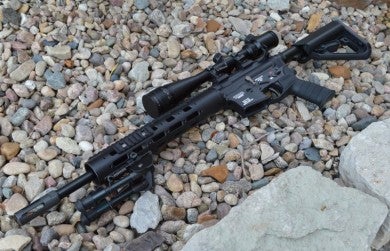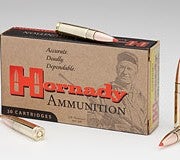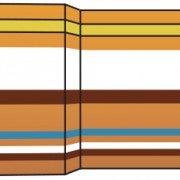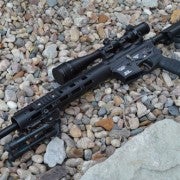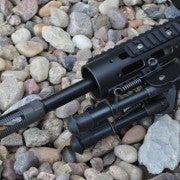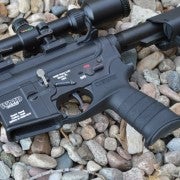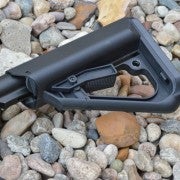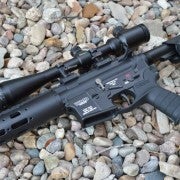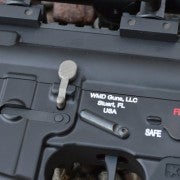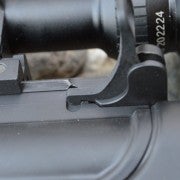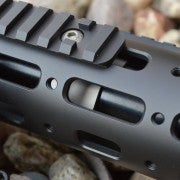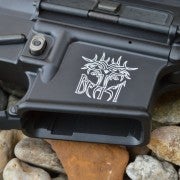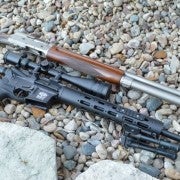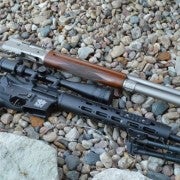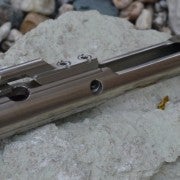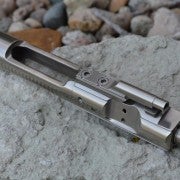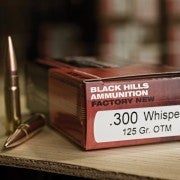.300 AAC Blackout… I Don’t Get It
Major Pandemic 05.22.14

Okay, so I feel like the guy in the room who doesn’t get the joke. Why was that funny, or in this case, why is everyone so nuts over .300 AAC Blackout? I am really really quite confused by the widespread infatuation with the cartridge, and I really don’t get it even after owning and shooting the round.
First let me say I do get the idea of the cartridge, and in fact I used to shoot the original JD Jone’s SSK 300 Whisper that AAC copied as the 300 Blackout–well, that they allegedly copied. The SSK design cut down a piece of .223 brass and opened it up to load a .308 round in it, and it’s powered with about as much powder as I put pepper on my salad.
Were these two great ideas conceived separately and independently? JD Jones did create the round first, and the Blackout followed after that. It’s really not my legal decision to make, but it does seem pretty odd that in most cases you can use the dies interchangeably. AAC did have outstanding marketing, and after begin purchased by Remington/Freedom Arms Group/DPMS, that marketing power increased exponentially. It was something new to sell and they did just that in a big way. Everyone wanted the 300 Blackout round.
So yeah, I get the round and its background, and I’ve shot it extensively. Theoretically, it’s great to have a hard hitting subsonic round that maintains very good accuracy with the 240gr Sierra Match King, but the sub-sonic 300 Blackout round we stuff into AR-15s will not actually cycle and function without a suppressor or funky pistol-length gas system.
Take a look at the original concept JD Jones came up with through his company SSK, and you will see that in fact he did create the first 300 Whisper functioning AR-15/M16 equipped with a 12-14” long suppressor, which no doubt provided enormous amounts of back pressure to cycle the round. The 300 Whisper subsonic rounds were designed to be fired suppressed, and the high velocity rounds were meant to be fired un-suppressed. There was some “tuning” to get everything to work reliably on the AR platform, but he was the first.
In all, it was an interesting R&D idea that certainly expanded the capabilities of the TC Contender target pistol, but as an AR-15 round, it makes about as much sense to me now as it did then–which is to say, not much.
The Idea
The round really was originally designed to be subsonic, ideally carrying a massively heavy 240gr Sierra Match King bullets to maximize energy at subsonic velocities. Bullets tend to destabilize as they drop from supersonic to subsonic and accuracy degrades. JD’s idea was to basically have a standard velocity sub-sonic round that could be lobbed accurately without the disturbance of the supersonic to subsonic bullet destabilization.
Originally, in that configuration it was a stunningly accurate mortar round even out to 1000-yards from a TC Contender handgun–I shot mine to 300-yards with excellent accuracy. SSK did AR-15 platform development allegedly to provide a long range, Hollywood-quiet, sniper round, but the positioning was a tough sell beyond niche military use. With the 240gr bullet, it was also very powerful for a subsonic round, delivering nearly 600 ft/lbs of energy or about 25%-30% more than we currently see from the production 200-220gr rounds.
Even in an AR, I still get the 300 Blackout/300 Whisper in a subsonic round when suppressed because it is very quiet. Take off the suppressor and your AR-15 becomes a single shot due to the lack of pressure to adequately cycle the sub-sonic round. Suppress the AR-15 and the operational gas pressure spikes up enough to reliably cycle a 300 Blackout/Whisper subsonic round.
Admittedly, the 300 Blackout does fill a very limited niche, delivering a 200+grain bullet downrange with about 480 ft/lbs of energy at the muzzle. So ballistically speaking, owners have a subsonic 30-round rifle that delivers the energy equivalent of a hot .45 ACP.
According to Hornday’s site, the 300 Whisper/300 Blackout 208gr AMax round delivers around 480 ft/lbs of energy and their own .45 Auto+P 230 gr HP XTP TAP® FPD round delivers 461 ft/lbs of energy. In essence you have a .45ACP H&K MP5 in the form of an AR-15. If you’re a door kicker and need something really really quiet with a lot of thump, the 300 is a great option. I totally get that idea on so many levels, but I question the reliability of the platform for that tactical situation. That is a very narrow use for the round, and it’s even more narrow considering the paperwork and restrictions to purchase a suppressor just to shoot the round the way it was designed.
The Rub: Performance
The only real way the 300 Blackout excels is subsonic, where the heavy high bullet weight can up the energy, but almost all factory loads top out at 220 grains and as a result the original concept is a bit neutered compared to its original intent.
The high velocity 300 Blackout round is still short of performance compared many similar sized rounds. In fact, compared to the old 30-30 lever action round, the 7.62×39 AK round, or even the .223 68-77gr rounds, the 300 Blackout falls short from a ballistics and energy perspective.
My problem is that once you drop the bullet weight to gain enough powder to make the 300 Blackout supersonic/high-velocity so that it will actually cycle in your average AR-15, you gain nothing over the .223 round. In fact at the 300-yard mark your typical 68-77 gr .223 round will be delivering more energy than that 300-Blackout/Whisper round, and at the muzzle they are nearly identical.
The .223 has proven itself to be an excellent soft target stopper without overpenetration. On steel and thick-hided hogs, the Blackout seems like a winner, but in most other cases the 300 has shown to be a consistently and severely over-penetrating round. There is no way I would risk using the 300 Blackout for home defense. That is perfect for thick skinned hogs at close distances, but not so great for anything else unless you are shooting through barriers–but then again the 7.62×39 AK round is still a better option and far far less expensive.
Pair that with a minimum price of $1.00 a round, compared to $0.40 per .223 round or even a $0.70 a round for .308, and all of a sudden I put the skids on a 300 Blackout build and started asking myself, ”Now why exactly I am doing this?”
As an alternative caliber, I have had the opportunity to shoot the Sharps 25-45, which is basically the same idea as the 300 Blackout but with a heavy 85 gr .25 caliber round. The round was specifically designed as a North American Game cartridge and delivers similar ballistics to the .223 at distances but ups the overall energy of the round to around 1700 Ft/lbs of energy–20% or around 400Ft/lb more than a .223 or 300 Blackout high velocity round. Let me tell you, this is an impressive sounding round when it hits steel, and it actually cycles reliably without being suppressed. Hunters have also been very impressed with the round on all manner of beast from elk to deer to boar.
If I want a subsonic thumper and own a 308 supressor, the 300 is a great option, but if I want full .308 bullet power, why wouldn’t I just use a .308 in a DPMS format .308 rifle that delivers far superior ballistics and allows me to reach all the way out to 1000-yards. This is the same way I feel about all the other goofy AR-15 format compatible rounds, including the 458 Socom.
People will cite cost as the main reason for not buying an entirely new rifle, but I would say that unless you are very occasional shooter, the ammo costs add up in favor of a complete .308 rifle vs just a .300 Blackout upper very quickly. With a $0.30 a round difference between the least expensive 300 Blackout and .308 rounds, you are saving around $300 per 1000 rounds with the .308/7.62×51 over the 300 Blackout.
The Known Reliability Issue
Simply put, the 300 Blackout in high velocity is barely delivering enough gas pressure with a carbine length gas system to cycle the action. Use a rifle length buffer and spring, heavy buffer, or “heavy carrier” and the problems increase substantially. Most manufacturers like Barnes Precision and WMD enlarge the gas port to up gas pressure and improve reliability. The pictured WMD Beast performed perfectly with Hornday 110gr AMAX rounds, but as expected with subsonic rounds, it needed a suppressor to up the pressure for cycling.
Subsonic rounds will still not cycle in an AR-15 action unless a suppressor is added or some odd build specs are adhered to. For example, my preference for a 300 Blackout build would be a 16”+ barrel with pistol length gas system, ultra light weight YM carrier, and lightweight carbine buffer.
The 300 Blackout is a known to be problematic in un-suppressed AR-15s for all but the the hotly loaded 110gr rounds. Even then I have had some reliability issues with the five 300-blackout rifles I have shot and tested when I have not stuck with the premium lines of ammo. Even with supersonic high velocity 110gr rounds and a carbine length gas system with an enlarged barrel gas port, the rifle is barely running. If your ammo maker is just a little off, you will have cycling issues. The only .300 Blackout chambered AR-15 I have shot which was reliable was a 16” barrel with a pistol-length gas system and enlarged gas port. In fact this rifle was only marginally reliable unsuppressed with sub-sonic rounds.
I Know Guys Who Love It
I am sure there are more than a few of you steaming at this point about my observations, but they are simply my observations. If you love the .300 Blackout, by all means don’t let me get under your skin. I have a couple of close friends who adore the round and who have to hear me swearing about the ammo availability and cost of the round. I have spoken with more than a few hog hunters who swear by the round running high velocity loads with a suppressor, but most will admit that the .308 still does a better job.
To me, the .300 Blackout’s success is all about great marketing. It’s the same reason we now have 3, 4, and 5 blade razors when a good old fashioned single edge safety razor actually does a better job for 1/100th the price.

